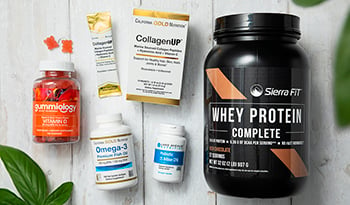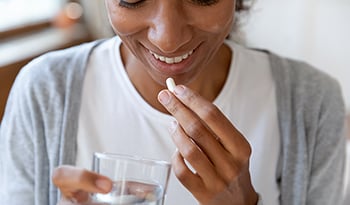3 Supplements To Boost Your Health Routine In The New Year
DISCLAIMER:This blog does not intend to provide diagnosis...
- In this article:
- Multivitamins Could Help Bolster a Healthy Diet
- Electrolytes Help Replenish Healthy Hydration Levels
- Green Tea Has Many Health Benefits

With the New Year approaching, you may be looking to recharge and reset. It’s been a tough year for many of us. Plus, the holidays can be stressful and after a season of overindulging, it’s never a bad idea to kick off the New Year in a positive and healthy way.
Three healthy habits you may want to consider trying in 2021 are: taking multivitamins, replenishing with electrolytes, and drinking green tea.
Multivitamins Could Help Bolster a Healthy Diet
Multivitamin/mineral (MVM) supplements are the most commonly used supplements in the world. Ideally, we would get all of the nutrients we need through our diet but the reality is that most Americans fall short. About 75% of adults do not consume the recommended intake of fruit and more than 80% do not consume the recommended intake of vegetables. We also don’t eat enough whole grains and low-fat dairy and we consume too many refined grains, saturated fat, added sugars, and sodium. These less than optimal dietary patterns contribute to obesity and chronic diseases such as cardiovascular disease and diabetes.
The 2015-2020 Dietary Guidelines specifically highlight several “shortfall nutrients,” which are nutrients that are under-consumed and thus may lead to adverse health effects. Vitamin D, calcium, potassium, and iron, in particular, are “nutrients of public health concern.” We also don’t get enough vitamin A, vitamin C, vitamin E, choline, and magnesium.
Since it is so difficult to get all of the nutrients you need through diet alone, you may want to consider taking an MVM. It can fill in nutritional gaps, improve your health, and may even reduce your risk of chronic disease.
Multivitamins contain a combination of vitamins and minerals and sometimes include other ingredients as well. They are available in many forms including pills, chewable gummies, powders, and liquids. Basic once-daily products are the most commonly used MVMs. These supplements typically contain all or most vitamins and minerals in amounts that are close to the recommended daily amounts. There are other higher-potency MVM products as well as those formulated for specific functions such as improved immunity or enhanced energy.
There’s no standard definition for MVMs as to what nutrients they must contain or at what levels. Rather, manufacturers choose which vitamins, minerals, and other ingredients to include in their products and in what amounts. Manufacturers are required to have a Supplemental Facts label and ingredient list on the products, so it’s important to always check the percent daily value (%DV) to see what percentage of your daily allotment you’re getting.
What Do Vitamins and Minerals Do?
Vitamins and minerals, also known as micronutrients, are substances that our bodies need to function normally. Together, they perform hundreds of critical roles in the body including building cells and proteins, converting food into energy, boosting the immune system, strengthening bones, building blood cells, contracting muscles, maintaining heart rhythm, and healing wounds.
Vitamins include fat-soluble and water-soluble vitamins. The fat-soluble vitamins are vitamin A, vitamin D, vitamin E, and vitamin K. The water-soluble vitamins are vitamin C and the B vitamins: thiamin (B1), riboflavin (B2), niacin (B3), pantothenic acid (B5), pyridoxine (B6), cobalamin (B12), biotin, and folic acid. Minerals include calcium, phosphorus, potassium, sodium, chloride, magnesium, iron, zinc, iodine, chromium, sulfur, cobalt, copper, fluoride, molybdenum, manganese, and selenium. Vitamins and minerals often work together in the body. For example, dietary vitamin C helps the body better absorb iron.
The Problem With Vitamin Deficiencies
Over time, an inadequate intake of essential vitamins and minerals can result in deficiencies that can negatively impact your health. For example, scurvy, a disease characterized by extreme weakness, swollen, bleeding gums, loose teeth, and skin sores, is caused by a deficiency of vitamin C. Sailors in the 15th to 18th centuries often succumbed to the disease due to a lack of fresh fruits and vegetables available on long sea voyages. Rickets is caused by vitamin D deficiency and is characterized by softened, weak bones, stunted growth and bone deformities. It is rarely seen today because milk has been fortified with vitamin D in an effort to eradicate the disease. Vitamin A deficiency causes night blindness, impaired wound healing, and anemia. It is the leading cause of preventable blindness in children worldwide.
Should You Take a Multivitamin?
Many people choose to take multivitamins as a type of nutritional insurance, to make sure that they’re getting the recommended amounts of vitamins and minerals when they can’t meet those needs from food alone. Specific populations may benefit from taking certain vitamins or minerals found in MVMs. For example:
- Vegetarians and vegans may need to supplement their diets with various nutrients including vitamin B12 and vitamin D.
- Women who might become pregnant need to get adequate amounts of folic acid to reduce the risk of neural tube defects in their babies. Note that cereal grain products are often fortified with folic acid to help prevent this problem.
- Pregnant women should take an iron supplement, which is typically achieved by taking a prenatal vitamin.
- Breastfed and partially breastfed infants may need vitamin D supplements
- Postmenopausal women may take calcium and vitamin D to slow down bone loss and reduce the risk of fractures.
- People over age 50 may need vitamin B12 supplementation.
Do Multivitamins Help Prevent Disease?
The studies looking at multivitamins to enhance health and prevent chronic disease are mixed and difficult to interpret for a couple of reasons. First of all, people who follow healthier diets and lifestyles are more likely to take dietary supplements, so it’s hard to identify if the benefits are from the supplements or other lifestyle factors. In addition, most of the studies have been observational rather than randomized controlled trials, so results can suggest an association but do not prove a cause and effect relationship.
One study of note is the Physicians Health Study II, the longest randomized controlled clinical trial to investigate whether MVMs might help prevent chronic disease. 14,641 male physicians aged 50 and older were assigned to take a daily MVM or placebo and were followed over a median of 11.2 years. The group taking MVMs were found to have a modest but significantly reduced risk of developing cancer (8%) although it did not reduce the risk of prostate cancer or overall cancer mortality. Also, there was no reduction in cardiovascular events, heart attacks, strokes, or cardiovascular-related deaths.
Another significant study was the Age-Related Eye Disease Study. Participants who were given high doses of vitamin C, vitamin E, beta-carotene, zinc, and copper were found to have a significantly reduced risk of developing age-related macular degeneration and loss of vision. Age-related macular degeneration (AMD) is the leading cause of blindness in the United States.
Risks and Precautions When taking Multivitamins
Taking a daily MVM is unlikely to cause a health risk for most people. However, there are cases in which taking excess amounts of a vitamin can cause adverse effects, so it is important to make sure that your total intake is not more than the safe upper limits for any nutrient. Some examples are:
- Excess amounts of vitamin A during pregnancy can increase the risk of birth defects.
- Men and postmenopausal women should not take iron supplements or an MVM containing more than their Recommended Daily Allowance for iron (8 mg/day) unless advised by their healthcare provider. Extra iron can build up in tissues like the liver and joints.
- People taking blood thinners should speak with their healthcare provider before taking any MVM containing vitamin K as it lowers the medicine’s effectiveness.
Electrolytes Help Replenish Healthy Hydration Levels
Electrolytes are minerals in our body fluids that carry an electric charge. They include sodium, potassium, calcium, chloride, magnesium, phosphate, and bicarbonate. Electrolytes are vital for normal functioning of the human body and are involved in many processes. They help maintain the balance of fluid in our bodies and maintain a normal pH (acidity/alkalinity). They move electrical impulses from cell to cell, helping to perform functions like stimulating nerve impulses, contracting muscle, and regulating your heartbeat. The kidneys play a key role in maintaining a stable level of fluid and electrolytes in our bodies. We get electrolytes from what we eat and drink and they’re found in many foods like fruits, vegetables, nuts, seeds, and dairy products.
Electrolyte Imbalances
Electrolyte imbalances can occur when the levels of electrolytes in your body are too high or low. These imbalances can have adverse effects on your health and in extreme cases can even be fatal. An electrolyte imbalance can present with a wide array of symptoms from mild symptoms like fatigue, irritability, numbness, and muscle cramps to more severe symptoms like altered mental status, irregular heartbeat, shortness of breath, and seizures.
One of the most common reasons for electrolyte imbalance is dehydration. Dehydration occurs when you lose more fluid than you take in. As a result, your body doesn't have enough water and other fluids to carry out its normal functions.
Dehydration can occur for a number of reasons such as:
- Vomiting and diarrhea
- Fever and/or infection
- Excessive sweating and/or intense exercise
- Medications (such as diuretics which cause increased urination)
Other medical conditions can cause electrolyte imbalances such as uncontrolled diabetes, kidney disease, congestive heart failure, severe injuries (like burns), and eating disorders.
There are many electrolyte products available on the market today including sports drinks, powder mixes, liquid concentrate, pills, dissolving tablets, and gummies. Some products are ready-to-drink formulations available in a bottle and others must be added to water. They can come in bulk-sized containers or individual serving packages. In addition to electrolytes, some of these products may also contain other ingredients like water and carbohydrates.
The type of product you choose will depend on a variety of factors, including your exercise habits. When considering products, take into account the type, duration, and intensity of your training. Another factor to consider is taste because that can affect how much of it you will consume. Research on athletes has shown that the flavor of sports drinks causes them to drink more than if they were consuming water alone.
One thing to keep in mind is that certain products, such as sports drinks, often contain large amounts of sugar—as much as a can of soda. If you’re drinking it after a workout, you may be taking in more calories than you’re burning during the workout. So be cautious and read the nutrition labels of any product you try.
Who Should Take Electrolytes?
For most people, a balanced diet should supply all of the electrolytes that you need. Our bodies have regulatory mechanisms to keep them all in the correct balance. However, electrolyte supplements can help replenish the fluid, electrolytes, and energy you lose in certain situations, such as during exercise. During physical activity, you need additional fluid to replace the water and electrolytes you lose in sweat. Sodium and chloride are the most abundant electrolytes found in sweat while potassium, magnesium, and calcium are present in smaller amounts.
It’s important to properly hydrate before, during, and after you exercise. Losing as little as 1-2% of your body’s water during a workout can lead to decreased focus and performance. Electrolyte replacement is most important during high-intensity exercise that lasts longer than 1 hour or if you’re exercising in a hot environment.
You might also want to consider taking an electrolyte if you’re ill, especially during bouts of vomiting or diarrhea when electrolyte abnormalities can be excessive. People with certain medical conditions may also benefit from taking supplemental electrolytes such as those with malabsorption syndrome, hormonal or endocrine disorders, or kidney disease.
Risks and Precautions When Taking Electrolytes
As with anything, taking too many electrolytes can cause adverse effects. For most healthy people, electrolyte supplements shouldn't cause a problem, but people with certain medical conditions or those who are on certain medications may be more prone to an electrolyte imbalance. For example, people with chronic kidney disease may be more susceptible to high levels of potassium and phosphate, which can be exacerbated by supplements. Hyperkalemia (high potassium levels) can cause chest pain, abdominal pain, nausea, vomiting, diarrhea, heart palpitations, irregular heartbeat, and muscle weakness. Hyperphosphatemia (high phosphate levels) can cause muscle cramps, numbness, tingling, bone pain, itching, and rash. People with certain types of cancer or those with parathyroid disorders may be prone to hypercalcemia (high calcium levels). This can cause bone pain, headaches, palpitations, nausea, vomiting, constipation, abdominal pain, muscle aches, cramping, and twitching.
Green Tea Has Many Health Benefits
Tea is one of the most widely consumed drinks in the world, second only to water. Drinking a cup of tea can be a soothing, relaxing ritual. But tea has also been used for medicinal purposes for centuries and now modern research is providing a scientific foundation for its health-promoting benefits.
Green tea comes from the camellia sinensis plant, the same plant that is used to make all traditional teas such as black tea, white tea, and oolong tea. The amount of oxidation that occurs to the leaves is largely responsible for the different types of tea. Just as an avocado or banana will brown when it is exposed to oxygen, tea leaves undergo a similar process after they are harvested. Tea leaves that are fully oxidized will darken and turn brown or black. This results in a product with a richer, more intense flavor. Tea leaves that are not oxidized at all will stay green and will yield a milder, more delicately flavored product. Green tea leaves are typically pan-fried or steamed to halt the oxidation process before they are dried. The amount of oxidation not only affects the flavor of the tea; it affects the chemical composition of the tea and thus its health benefits.
Green tea is available in many different forms, including loose tea leaves, tea bags, powdered, bottled, and in supplements sold as capsules or liquid extract. Matcha, which literally means “powdered tea,” is a special form of green tea. It’s made from grinding green tea leaves into a fine powder. It’s harvested in a slightly different way than traditional green tea and has an intense taste that’s sometimes described as grass- or spinach-like. It’s traditionally prepared by whisking it with hot water to create a frothy drink.
Health Benefits of Green Tea
Green tea relaxes the mind, enhances your mood, and may boost focus and memory. This is due to a combination of caffeine and a unique amino called L-theanine. Caffeine has been shown to improve various aspects of brain function, including memory, alertness, and mood. L-theanine increases the activity of the inhibitory neurotransmitter gamma-aminobutyric acid (GABA), which has anti-anxiety effects. It also increases the production of mood-enhancing neurotransmitters dopamine and serotonin.
Green tea is also loaded with polyphenols, which are natural plant-based compounds that have antioxidant and anti-inflammatory properties. Antioxidants are compounds that neutralize harmful free radicals that cause damage to your cells and increase your risk of chronic diseases like heart disease, autoimmune disease, and cancer. Inflammation is also thought to be the root cause of many chronic illnesses and premature aging.
Catechins are a specific type of polyphenol, and green tea has an especially high amount of a catechin called epigallocatechin-3-gallate (EGCG). EGCG is responsible for many of the health-promoting effects of green tea.
There are a number of ways that these plant-based compounds may positively affect your health including:
- Promoting heart health by decreasing cholesterol, lowering blood pressure and improving blood flow in vessels
- Helping to regulate blood sugar
- Supporting brain health
- Boosting immunity
- Boosting metabolism
- Supporting weight management
- Supporting bone density
- Protecting skin from aging
If all of that is not enough to convince you, green tea may even help you live longer. In a study that followed over 40,000 Japanese adults, the consumption of green tea was associated with reduced mortality due to all causes, especially cardiovascular disease. To sum it up, you may want to consider making green tea a regular part of your daily routine. Not only can it help relax the mind and soothe the soul, it may also provide an enormous boost to your health!
Risks and Precautions When Taking Green Tea
While drinking green tea is safe for most adults, there are some potential side effects. Many of the side effects occur only when consumed in massive amounts, which is more likely to occur when taking green tea supplements rather than drinking tea. These side effects are mainly from the caffeine in green tea. While green tea contains only a moderate amount of caffeine (about 35 milligrams in an 8-ounce cup), the caffeine content varies depending on the amount of tea used and the amount of time the leaves steep. People who are sensitive to caffeine can experience symptoms such as headache, anxiety, insomnia, and stomach upset. Pregnant women should be sure that they are limiting their caffeine intake as recommended by their doctor. In rare cases, green tea can interfere with iron absorption in the body and cause anemia. Supplements containing very high levels of EGCG have also been linked to liver damage. Green tea may also potentially interact with certain medications so be sure to check with your healthcare provider before consuming large amounts of it.
References:
- US Department of Health and Human Services and US Department of Agriculture. 2015-2020 Dietary Guidelines for Americans December 2015. Available at: https://health.gov/dietaryguidelines/2015/. Accessed 4/23/18.)
- National Institutes of Health Office of Dietary Supplements
- Bird JK, Murphy RA, Ciappio ED, McBurney MI. Risk of Deficiency in Multiple Concurrent Micronutrients in Children and Adults in the United States. Nutrients. 2017;9(7):655. Published 2017 Jun 24. doi:10.3390/nu9070655 https://www.who.int/health-topics/micronutrients#tab=tab_1
- Gaziano JM, Sesso HD, Christen WG, et al. Multivitamins in the Prevention of Cancer in Men: The Physicians' Health Study II Randomized Controlled Trial. JAMA. 2012;308(18):1871–1880. doi:10.1001/jama.2012.14641
- Sesso HD, Christen WG, Bubes V, et al. Multivitamins in the Prevention of Cardiovascular Disease in Men: The Physicians' Health Study II Randomized Controlled Trial. JAMA. 2012;308(17):1751–1760. doi:10.1001/jama.2012.14805
- Chew EY, Lindblad AS, Clemons T; Age-Related Eye Disease Study Research Group. Summary results and recommendations from the age-related eye disease study. Arch Ophthalmol. 2009;127(12):1678-1679. doi:10.1001/archophthalmol.2009.312
- Age-Related Eye Disease Study Research Group. A randomized, placebo-controlled, clinical trial of high-dose supplementation with vitamins C and E, beta carotene, and zinc for age-related macular degeneration and vision loss: AREDS report no. 8. Arch Ophthalmol. 2001 Oct;119(10):1417-36. doi: 10.1001/archopht.119.10.1417. Erratum in: Arch Ophthalmol. 2008 Sep;126(9):1251. PMID: 11594942; PMCID: PMC1462955.
- Passe DH, Horn M, Stofan J, Murray R. Palatability and voluntary intake of sports beverages, diluted orange juice, and water during exercise. Int J Sport Nutr Exerc Metab. 2004 Jun;14(3):272-84. doi: 10.1123/ijsnem.14.3.272. PMID: 15256688.
- American College of Sports Medicine, Sawka MN, Burke LM, Eichner ER, Maughan RJ, Montain SJ, Stachenfeld NS. American College of Sports Medicine position stand. Exercise and fluid replacement. Med Sci Sports Exerc. 2007 Feb;39(2):377-90. doi: 10.1249/mss.0b013e31802ca597. PMID: 17277604.
- Thomas DT, Erdman KA, Burke LM. Position of the Academy of Nutrition and Dietetics, Dietitians of Canada, and the American College of Sports Medicine: Nutrition and Athletic Performance. J Acad Nutr Diet. 2016 Mar;116(3):501-528. doi: 10.1016/j.jand.2015.12.006. Erratum in: J Acad Nutr Diet. 2017 Jan;117(1):146. PMID: 26920240.
- Jeukendrup AE. Nutrition for endurance sports: marathon, triathlon, and road cycling. J Sports Sci. 2011;29 Suppl 1:S91-9. doi: 10.1080/02640414.2011.610348. Epub 2011 Sep 15. PMID: 21916794.
- Ruxton, C.H.S. (2008) The Impact of Caffeine on Mood, Cognitive Function, Performance and Hydration: A Review of Benefits and Risks. Nutrition Bulletin, 33, 15-25.
- Nathan PJ, Lu K, Gray M, Oliver C. The neuropharmacology of L-theanine(N-ethyl-L-glutamine): a possible neuroprotective and cognitive enhancing agent. J Herb Pharmacother. 2006;6(2):21-30. PMID: 17182482.
- Pham-Huy LA, He H, Pham-Huy C. Free radicals, antioxidants in disease and health. Int J Biomed Sci. 2008;4(2):89-96.
- Hunter P. The inflammation theory of disease. The growing realization that chronic inflammation is crucial in many diseases opens new avenues for treatment. EMBO Rep. 2012;13(11):968-970. doi:10.1038/embor.2012.142
- Chen ZM, Lin Z. Tea and human health: biomedical functions of tea active components and current issues. J Zhejiang Univ Sci B. 2015;16(2):87-102. doi:10.1631/jzus.B1500001
- Kuriyama S, Shimazu T, Ohmori K, Kikuchi N, Nakaya N, Nishino Y, Tsubono Y, Tsuji I. Green tea consumption and mortality due to cardiovascular disease, cancer, and all causes in Japan: the Ohsaki study. JAMA. 2006 Sep 13;296(10):1255-65. doi: 10.1001/jama.296.10.1255. PMID: 16968850.
- Mead MN. Temperance in green tea. Environ Health Perspect. 2007;115(9):A445. doi:10.1289/ehp.115-a445a
- Wikoff D, Welsh BT, Henderson R, Brorby GP, Britt J, Myers E, Goldberger J, Lieberman HR, O'Brien C, Peck J, Tenenbein M, Weaver C, Harvey S, Urban J, Doepker C. Systematic review of the potential adverse effects of caffeine consumption in healthy adults, pregnant women, adolescents, and children. Food Chem Toxicol. 2017 Nov;109(Pt 1):585-648. doi: 10.1016/j.fct.2017.04.002. Epub 2017 Apr 21. PMID: 28438661.
- Fan FS. Iron deficiency anemia due to excessive green tea drinking. Clin Case Rep. 2016;4(11):1053-1056. Published 2016 Oct 5. doi:10.1002/ccr3.707
- Oketch-Rabah HA, Roe AL, Rider CV, et al. United States Pharmacopeia (USP) comprehensive review of the hepatotoxicity of green tea extracts. Toxicol Rep. 2020;7:386-402. Published 2020 Feb 15. doi:10.1016/j.toxrep.2020.02.008
- Patel SS, Beer S, Kearney DL, Phillips G, Carter BA. Green tea extract: a potential cause of acute liver failure. World J Gastroenterol. 2013;19(31):5174-5177. doi:10.3748/wjg.v19.i31.5174
- Samman S, Sandström B, Toft MB, Bukhave K, Jensen M, Sørensen SS, Hansen M. Green tea or rosemary extract added to foods reduces nonheme-iron absorption. Am J Clin Nutr. 2001 Mar;73(3):607-12. doi: 10.1093/ajcn/73.3.607. PMID: 11237939.

 By Dr. Sonali Ruder, D.O.
By Dr. Sonali Ruder, D.O.


